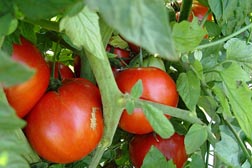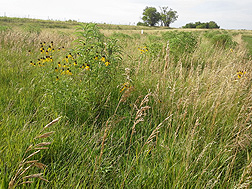| January 2017 |
Test Uses Novel Antibodies to Detect Shiga ToxinsARS scientists have developed a highly sensitive test that for the first time can identify all known subtypes of Shiga toxin-producing E. coli (STEC) including new and emerging serotypes. The tests rely on ARS-patented antibodies. Additional studies have shown that these antibodies also can detect Shiga toxins in blood, an indication that they can potentially be adapted as therapeutics for human diseases caused by Shiga toxins. The new antibodies have been licensed to Abraxis LLC, TechLab, Inc., and List Biological Laboratories Inc. Scientific contact: Xiaohua He, (510) 559-5823, Foodborne Toxin Detection and Prevention Research Unit, Western Regional Research Center, Albany, California. |
|
|
|
Adequate Zinc Vital to Healthy Immune ResponseA group of older adults with relatively low blood zinc concentrations boosted their immune function by raising their zinc levels, according to an ARS-funded study. The researchers recruited participants 65 or older from Boston-area nursing facilities. More than 30 percent of the participants tested low in zinc. Researchers divided the zinc-deficient participants into two groups. For three months, one group consumed 30 mg of additional zinc via a daily multivitamin supplement, and a control group received a similar supplement that contained 5 mg of zinc. While the recommended dietary intake is 8-11 mg daily, the higher level was used because many volunteers had low blood zinc levels. The researchers then retested the participants' blood zinc levels and T cell numbers. They found that participants who took 30 mg of supplemental zinc had higher blood zinc concentrations and higher T-cell counts as well as better T-cell function than those in the control group. For details, contact: Simin Nikbin Meydani, (617) 556-3129, Jean Mayer USDA Human Nutrition Research Center on Aging, Tufts University, Boston, Massachusetts. |
USDA Announces New Open Data Partnership for Public HealthThe USDA Branded Food Products Database, a free online resource for families, the food industry and researchers containing nutrition details on more than 80,000 name brand prepared and packaged foods available at restaurants and grocery stores was launched in September 2016. ARS partnered with the International Life Sciences Institute North America (ILSI North America), GS1 US, 1WorldSync, and Label Insight to develop the new database and user-friendly interface to make it easier for private food companies to add and update data. The database provides a transparent source of information that can assist health professionals identifying foods and portion size for people with food allergies, diabetes, kidney disease and other conditions. Common consumer health and nutrition Apps may also use the data as a resource to bring information to consumers on a phone or watch in real time while shopping or dining out. The Branded Food Products Database greatly expands and enhances, the USDA National Nutrient Database, which contained basic information on about 8,800 branded foods and serves as the main source of food composition data for government, researchers and the food industry. As information is added in the coming months, it is expected the new database will include up to 500,000 products with an expanded level of detail including serving size, servings per package and nutrients shown on the Nutrition Facts Panel or the Expanded Nutrition Facts Panel, plus weights and measures, ingredient list and sub-list, and a date stamp associated with current formulation of the product. For details, contact: Pamela Starke-Reed, (301) 504-7050, Deputy Administrator, Nutrition, Food Safety/Quality, Beltsville, Maryland. |
|
|
|
Detecting Decay Inside Bagged Lettuce with 'Electronic Eye'Fresh-cut lettuce sold in bags is a desirable yet highly perishable product because tissue decay can start a few days after processing and is difficult to detect through the bag with the naked eye. ARS and Australian researchers have developed two lettuce-decay indices to help select breeding lines yielding longer-lasting cut lettuce. The indices also allow researchers to identify lettuce damage caused by freezing temperatures. One index is based on evaluations performed with hyperspectral imaging. A hyperspectral sensor identifies decay by measuring light waves that bounce off plant tissues. Unlike the human eye, which sees only visible light, hyperspectral imaging detects a much broader electromagnetic spectrum—including the ultraviolet, near-infrared, and infrared regions. The index is based on chlorophyll fluorescence imaging, which measures biological activity in leaf tissue and uses light re-emitted by chlorophyll to find decay. For details, contact: Ivan Simko, (831) 755-2862, Crop Improvement and Protection Research Laboratory, Salinas, California. |
Higher Dose of Vitamin D May Benefit Pregnant WomenMore vitamin D during pregnancy may reduce inflammation, according to ARS and University of California, Davis scientists in The Journal of Nutrition. Reducing inflammation during pregnancy is important because inflammation is associated with high blood pressure, pre-eclampsia, premature delivery and low birthweight. Healthy women in their first trimester of pregnancy took either 400 IU vitamin D and a placebo pill or 400 IU vitamin D and an additional 1600 IU vitamin D pill. Vitamin D dose did not affect maternal blood pressure or infant birthweight. However, the higher daily dose correlated with lower circulating tumor necrosis factor-α (TNF-α), an immune substance typically associated with inflammation. They also found the higher level of vitamin D increased the proportion of a specific subset of immune cells with anti-inflammatory properties that may prevent adverse effects of excess inflammation. For details, contact: Charles Stephensen, (530) 754-9266, Western Human Nutrition Research Center, Davis, California. |
|
|
|
Two Approaches to Enhancing Tomato FlavorARS scientists studied the effects of "blanching"—refrigerating and then dipping tomatoes in hot water to make them easier to peel—on the flavor of tomatoes. They used gas chromatography and an "electronic nose" to measure 45 volatile compounds associated with flavor released when the tomatoes were cut up. The results showed that refrigeration greatly reduced 25 of 42 aroma compounds and reduced volatile levels overall by 68 percent. Blanching also greatly reduced 22 of 42 compounds and reduced volatile levels overall by 63 percent. The results spelled out why it is better to store tomatoes—and wash them just before use—at room temperature. Another ARS researcher identified tomato varieties and growing seasons best suited for two of Florida's major tomato production areas: south Florida and west-central Florida with harvests timed for March, June and December. Human taste-test panels evaluated flavor. Sugars, acids and 29 key aroma compounds in 38 types of tomatoes also were measured over seven years. The results showed tomatoes need to have a certain amount of acids to have adequate flavor and the more sugar they contain, the better they taste. Tomatoes harvested in June had more sugar and fruity volatiles than those harvested in December, probably because they received more sunshine. Tomatoes harvested in March ranked in the middle in flavor. For details, contact: Jinhe Bai, (772) 462-5880 and Elizabeth Baldwin, U.S. Horticulture Research Laboratory, Fort Pierce, Florida. |
New Rice Flour Mixes Available To Make Yummy TreatsConsumers can now buy double chocolate chip brownie, chocolate chip cookie and lemon poppy seed muffin mixes made from a rice flour blend developed by ARS scientists that reduces oil absorption during cooking. The products are available under the brand name Choice Batter® from CrispTek LLC. Nutritionally and functionally, rice ingredients are equal or superior to their wheat-based counterparts, but they absorb 50 percent less oil than traditional wheat batters and can be used for grilling, baking and frying. Rice ingredients also are gluten free, which is important for people who have celiac disease, which causes an autoimmune reaction to wheat proteins. They are also free of the eight most common food allergens such as peanuts, dairy foods and soy. For details, contact: Kim Daigle, (504) 286-4381, Food Processing and Sensory Quality Research Unit, New Orleans, Louisiana. |
|
|
|
Christopher B Watkins Delivered 2016 Morrison Memorial Lecture at ASHS Conference"New Technologies for Storage of Horticultural Products—There Is More to Adoption Than Availability" was the title of Christopher B. Watkins' 2016 ARS B.Y. Morrison Memorial Lecture, which he delivered at the American Society for Horticultural Science (ASHS) annual conference in Atlanta in August. Watkins has contributed to the success of fruit and floral industries around the world as a leader in postharvest science and outreach. His research advancing controlled atmosphere biology, edible quality of fruit management, and chilling injury prevention is used across varieties, across species, and across production areas. In particular, Watkins has been at the forefront of addressing significant apple industry issues by applying new developments in postharvest technologies. His research about the artificial ripening regulator 1-methylcyclopropene (1-MCP) has been instrumental in developing our understanding of apple ethylene biology, both from a scientific standpoint and from industry's applied perspective and practical need to control ripening. For details, contact: Kim Kaplan, (301) 504-1637, Lecture Coordinator, ARS Office of Communications, Beltsville, Maryland. |
Antibiotic Resistance Can Occur Naturally in Soil BacteriaARS scientists have found antibiotic-resistant bacteria in prairie soils that had little or no exposure to human or animal activity. The team examined native prairie soils that had little human impact and no animal grazing during the past 20 years. They collected soil samples from the sites and screened them for antibiotic-resistant bacteria. They found that all prairies contained bacteria that were resistant to tetracycline and cefotaxime—two commonly prescribed antibiotics that treat a wide variety of infections—and nearly half of the samples contained bacteria resistant to two or more antibiotics. Data from the study should provide a baseline for what occurs naturally in soil-giving scientists a starting point for figuring out how best to manage antibiotic resistance in agricultural productions. For details, contact: Lisa Durso, (402) 472-1484, Agroecosystem Management Research Unit, Lincoln, Nebraska. |
|
|
|
Two New Berries for You from ARSBaby Blues, a blueberry cultivar, is a vigorous, high-yielding, small-fruited, machine-harvestable highbush blueberry with outstanding fruit quality. It is well suited for processing markets that require a small fruit size. Baby Blues should offer growers and processors an alternative to the low-yielding Rubel highbush blueberry, and it should thrive in milder areas where northern highbush blueberries are grown. Columbia Giant, a new thornless, trailing blackberry is high-yielding, machine-harvestable with firm, sweet fruit. The fruit quality is similar to or better than that of the industry standards Marion and Black Diamond. Due to its extremely large size, Columbia Giant will mostly be sold in the fresh market. It is adaptable to areas where other trailing blackberries thrive. For details, contact: Chad E. Finn, (541) 738-4037, Horticultural Crops Research Laboratory, Corvallis, Oregon. |











